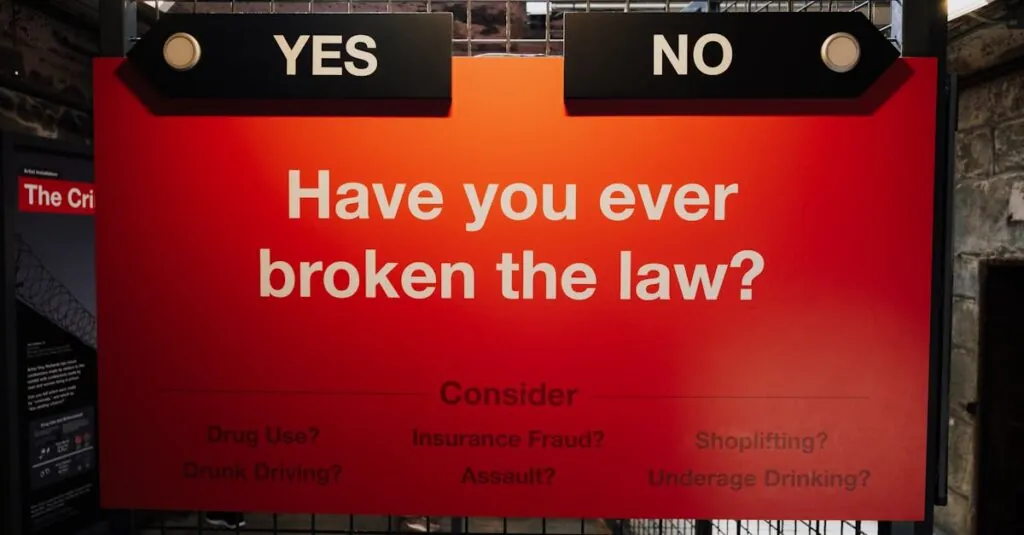Table of Contents
ToggleMoving can feel like a high-stakes game of Tetris, where one wrong move could lead to a cascade of broken dishes and misplaced heirlooms. Amidst the chaos of packing boxes and negotiating with stubborn furniture, it’s easy to overlook a crucial element: insurance. But don’t worry, it’s not as boring as it sounds—think of it as a safety net for your prized possessions.
Overview of Insurance Options for Movers
Movers face various insurance options to protect their belongings during transit. Each option offers different levels of coverage and cost, catering to diverse needs.
The most basic option provided by movers is the “Released Value Protection.” This coverage usually costs no extra fee and provides minimal protection at a rate of 60 cents per pound for damaged items. For instance, if a 50-pound item sustains damage, the reimbursement totals only $30.
“Full Value Protection” presents a more comprehensive solution. This type allows for repair, replacement, or cash value for lost or damaged items. Movers often charge additional fees for this coverage, generally around 1% to 2% of the total shipment value. Thus, a $10,000 shipment may incur a premium between $100 and $200.
Another alternative is “Third-Party Insurance.” This coverage involves acquiring a separate policy from a private insurance company. It allows movers to safeguard their belongings more thoroughly, potentially providing higher payout limits and more extensive protection against damages.
“Homeowner’s Insurance” can also cover items in transit. Many homeowner’s policies offer coverage for personal property, even while moving. However, limits and terms vary, so reviewing the specific policy is essential to ensure adequate protection.
Plan accordingly by discussing insurance options with the moving company. Assessing coverage details, costs, and any exclusions aids in making informed decisions. Effective insurance options not only alleviate worries but also enhance peace of mind throughout the moving process.
Types of Insurance Options
Understanding the various insurance options helps movers protect their belongings during transit. Each type caters to different needs and offers varying levels of coverage.
Basic Coverage
Basic coverage, also known as Released Value Protection, provides minimal protection. This option comes at no extra cost but only offers a payout of 60 cents per pound for damaged items. Movers frequently find this insufficient for valuable possessions. It’s important to assess the weight of items when considering this option, as the payout may not cover replacement costs for high-value goods.
Full Value Protection
Full Value Protection delivers more extensive coverage for an additional fee. Under this plan, moving companies are responsible for repairing or replacing lost or damaged items. Movers appreciate this for providing peace of mind, especially for valuable or fragile items. It’s crucial to read the terms carefully, as exclusions may apply, affecting specific items or situations. Choosing this option helps ensure adequate protection throughout the moving process.
Liability Coverage
Liability coverage acts as a safety net for movers. This protects against accidents that may occur during transportation. While it varies by company, liability coverage typically accounts for damage to items caused by the movers’ negligence. Evaluating the terms and limits of this coverage is essential. Discussing options with the moving company ensures an understanding of liability policies in place during the move.
Factors to Consider When Choosing Insurance
Choosing the right insurance for moving involves several important factors. Evaluating each aspect ensures adequate protection for belongings.
Value of Your Belongings
Consider the monetary worth of your items before selecting insurance. High-value possessions require robust coverage. Full Value Protection or Third-Party Insurance often suits valuable items best. Specifically, valuable items like electronics or art may exceed the limits of Released Value Protection. Evaluate item appraisals and replacement costs to guide decisions effectively.
Distance of the Move
Distance plays a critical role in insurance selection. Local moves may involve different risks than long-distance relocations. Short moves might face fewer challenges, leading to potential lower insurance needs. Conversely, long-distance moves entail increased vulnerability to damage or loss, making more comprehensive insurance essential. Factoring distance helps in determining the appropriate type and level of coverage.
Provider Reputation
Researching the moving company’s reputation is essential. Companies with strong, positive reviews tend to offer better insurance options. Look for customer feedback regarding claims processing and overall service quality. Verified ratings from agencies like the Better Business Bureau can offer insights. A reputable provider not only protects belongings but also ensures a smoother claim experience if issues arise.
How to File a Claim
Filing a claim involves a clear understanding of the process. Start by contacting the moving company to report the damage or loss. Most companies require notification within a specific timeframe, often within 30 days of the incident. Gather all relevant information, including the inventory list, photographs of damaged items, and any receipts for valuable belongings.
Prepare to fill out a claims form provided by the moving company. This form typically requests detailed descriptions of the damage and supporting documents. Providing comprehensive documentation can facilitate a smoother claims process. It’s important to keep copies of all submitted materials for personal records.
Submit the completed claim form along with the required documentation. If using Full Value Protection, the moving company may need to repair or replace damaged items. Under Released Value Protection, reimbursement may only cover a set amount, such as 60 cents per pound.
Monitor the progress of the claim regularly. Claims may take several weeks to process, depending on the company’s policies. If any concerns arise during the process, maintain communication with the moving company.
Stay aware of any scheduled timelines for draft responses or resolutions. Always follow up if feedback isn’t received within the expected timeframe. Understanding the nuances of liability coverage and third-party insurance can also enhance clarity during the claims process.
Navigating the complexities of moving can be daunting but understanding insurance options can significantly ease the process. By carefully evaluating the available coverage—whether it’s Released Value Protection, Full Value Protection, or Third-Party Insurance—movers can better safeguard their belongings. It’s crucial to consider the value of items and the distance of the move when selecting the right insurance. A well-informed choice not only protects valuable possessions but also enhances peace of mind during a chaotic time. Engaging in open discussions with the moving company about insurance options ensures that movers are adequately covered, allowing them to focus on the excitement of their new journey.





